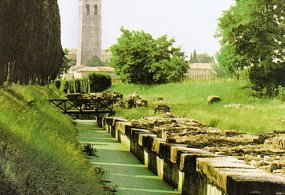 Hotel Marco Polo
**
The Hotel Marco Polo is located...
Via Miramare, 8 -
Sabbiadoro
Hotel Marco Polo
**
The Hotel Marco Polo is located...
Via Miramare, 8 -
Sabbiadoro
 Hotel Anapaya
****
Having undergone complete renovation...
Arco del Libeccio, 40 -
Pineta
Hotel Anapaya
****
Having undergone complete renovation...
Arco del Libeccio, 40 -
Pineta
 Hotel Bella Venezia Mare
****
The Hotel Bella Venezia Mare enjoys...
Arco del Grecale, 18/A -
Pineta
Hotel Bella Venezia Mare
****
The Hotel Bella Venezia Mare enjoys...
Arco del Grecale, 18/A -
Pineta
 Hotel La Perla
***
A friendly and intimate hotel created...
Via Padana, 10 -
Sabbiadoro
Hotel La Perla
***
A friendly and intimate hotel created...
Via Padana, 10 -
Sabbiadoro
 Hotel Astro
****
A warm and family atmosphere welcomes...
Viale Miramare, 48 -
Sabbiadoro
Hotel Astro
****
A warm and family atmosphere welcomes...
Viale Miramare, 48 -
Sabbiadoro

Region: Friuli Venezia Giulia
Elevation: 5 m a.s.l.
Area: 36,84 km2
Population: 3.503 (as of June, 2009)
Gentilic: Aquileiesi
Patron: Saints Ermacora and Fortunato
Patron-Day: July, 12
Aquileia was founded as military colony by Romans in 181 BC to counter the advance of barbarian people. Soon the city became an important starting point for expeditions and military conquests, in addition to become an important trade centre. Under the reign of Caesar Augusts it reaches its climax with a huge population and become the residence of many emperors.
With the Edict of Milan in 313 AD, Christianity explodes in public, showing a large and fast development. The bishops of Aquileia grow in importance in the following centuries, giving a strong contribution to the development of Western Christianity, both in terms of doctrine and for the authority exercised.
Aquileia withstands to the several incursions of barbarian people, but not to Attila, who penetrates in the city in 452, devastating it and spreading salt on the ruins. The authority of the church and the myth of a city that had been strong survive, though now the direct control of Aquileia is limited to a very small area. From 568, after the Lombard invasion, the region of Aquileia is divided between the Roman-Byzantine and the Lombards. The city still continues to give his name to the patriarchy, even when in the fifteenth century was occupied by the Republic of Venice.
After a short passage in the Holy Roman Empire, the city follows the fortunes of the Venetian Republic, and was annexed by the Habsburgs with the Treaty of Campoformido until his final union with the rest of the Friuli and Italy after the First World War.
The Basilica is a real museum where you can find different architectural styles, mosaics and frescoes of great value. Begun soon after the edict of Milan, after several restorations and additional buildings, the church still retains the shape of the eleventh century. Of particular interest are the mosaic floors that cover almost the entire church. Among the ancient walls of the Basilica has maintained an amazing mosaic floor of the start of the fourth century in an exceptional state of preservation.
The National Archaeological Museum is the largest of northern Italy for the wealth of remains from Roman times.
Fascinating are the Forum, the Cemetery and the Port River.